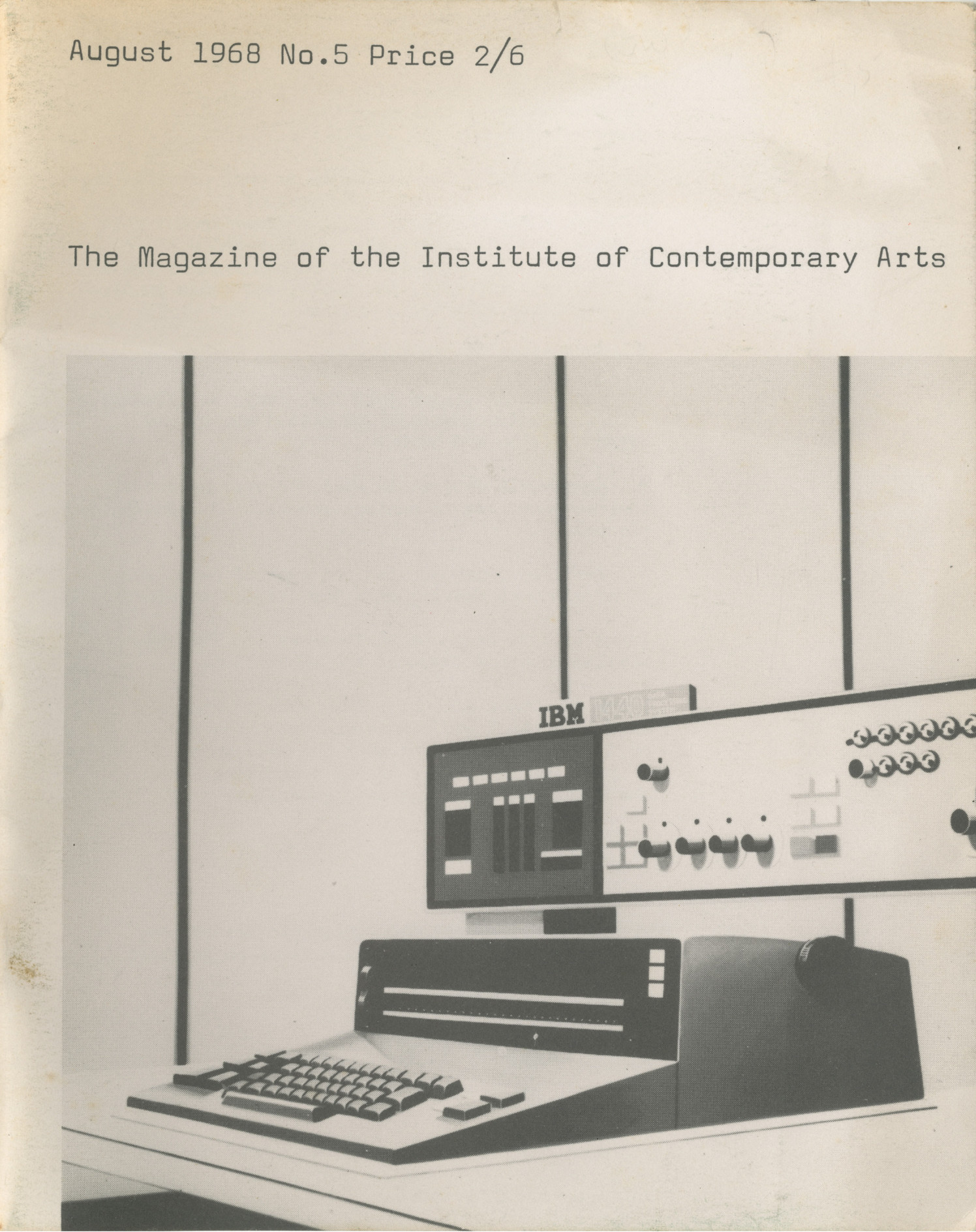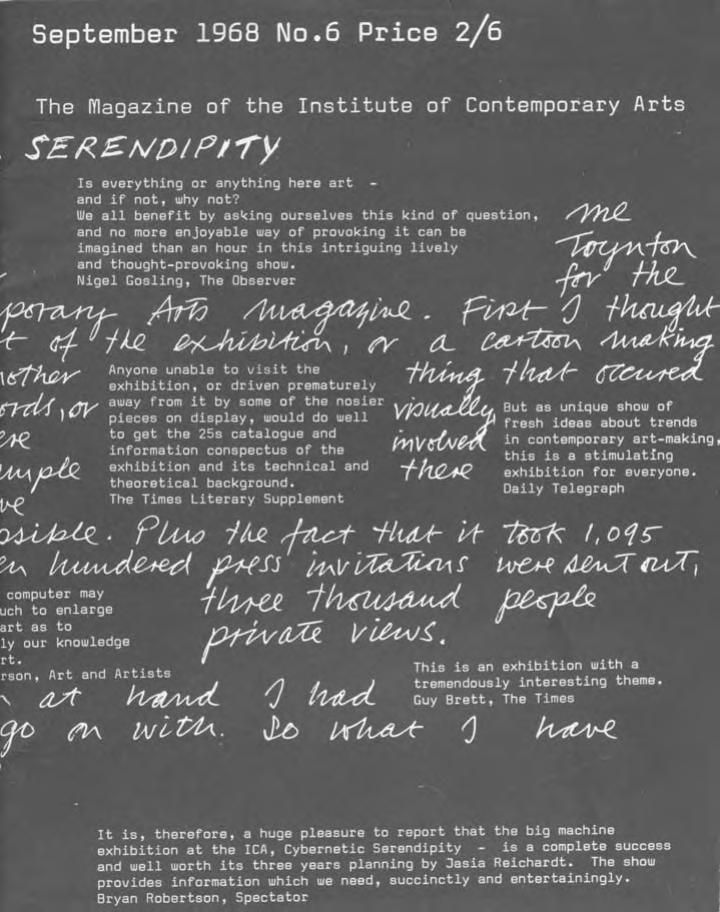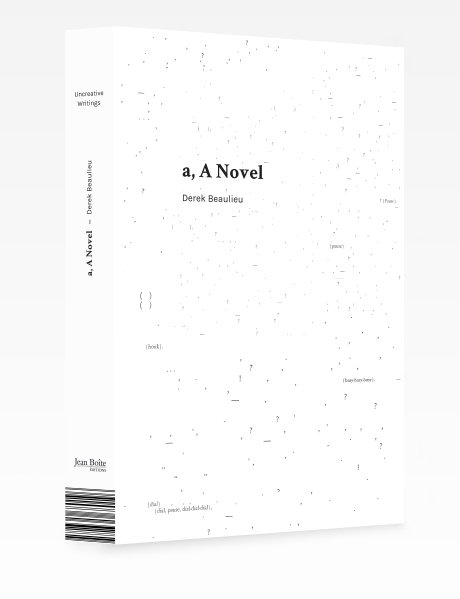Between Poetry and Painting (1965)
Filed under catalogue | Tags: · art, concrete poetry, painting, poetry, visual poetry

The catalogue for Between Poetry and Painting, an exhibition that was curated by Jasia Reichardt and held at the Institute of Contemporary Arts, London, from 22 October 1965 to 27 November 1965. The purview is work at the confluence of poetry and painting, with a particular emphasis on visual poetry and adjacent forms.
Exhibiting artists include: Pierre Albert-Birot, Nanni Balestrini, Thomas Bayrle/Bernhard Jäger, Claus Bremer, Henri Chopin, Bob Cobbing, Kenelm Cox, Klaus-Peter Dienst, Rolf-Gunter Dienst, Reinhard Döhl, Tom Edmonds, Ian Hamilton Finlay, Barry Flanagan, John Furnival, Heinz Gappmayr, Pierre Garnier, PA Gette, Eugen Gomringer, Raoul Hausmann, Bernard Heidsieck, Joseph Hirsal, Dom Sylvester Houédard, Ernst Jandl, Thomas Kabdebo, Jiří Kolář, Ferdinand Kriwet, John Latham, Roberto Altmann, Isidore Isou, Maurice Lemaître, Gio Minola, Roland Sabatier, Jacques Spacagna, Hansjörg Mayer, Franz Mon, Edwin Morgan, Ronaldo Azeredo, Augusto de Campos, Haroldo de Campos, Décio Pignatari, Pedro Xisto, Ladislav Novák, Antonio Porta/Romano Ragazzi, Josua Reichert, Dieter Rot, Gerhard Rühm, John Sharkey and Hans Staudacher.
Edited by Jasia Reichardt
Publisher Institute of Contemporary Arts, London, 1965
81 pages
via James Ryan (xfoml)
PDF (17 MB)
Internet Archive
The Magazine of the Institute of Contemporary Arts, 5-6: Cybernetic Serendipity (1968)
Filed under magazine | Tags: · art, computer art, computer graphics, concrete poetry, op art, visual poetry


Two issues of ICA London’s magazine dedicated to the seminal exhibition exploring relationships between arts and cybernetics, Cybernetic Serendipity.
The Issue 5 contains texts by Martin Gardner on Op art, Pierre Barbaud on information theory and music, Charles Csuri on his computer art, and an essay on Andrew Rawlinson’s concrete poetry.
The Issue 6 has texts by Daphne Oram, Max Bense, Petar Milojevic, and Nam June Paik.
Edited by Jasia Reichardt
Publisher Institute of Contemporary Arts, London, Aug & Sep 1968
38 & 38 pages
Issue 5: PDF (41 MB, via johnsta)
Issue 6: PDF (3 MB, added on 2022-12-15, via Experimental TV Center)
Derek Beaulieu: a, A Novel (2017)
Filed under artist publishing, poetry | Tags: · conceptual writing, uncreative writing, visual poetry

“Derek Beaulieu’s a, A Novel is an erasure-based translative response to Andy Warhol’s eponymous novel. Beaulieu carefully erases all of the text on each page of the original work, leaving only the punctuation marks, typists’ insertions and onomatopoeic words. The resultant text is a novelistic ballet mécanique, a visual orchestration of the traffic signals and street noise of 1960’s New York City. This visually powerful half score/half novel highlights the musicality of non-narrative sounds embedded within conversation.
Published in December 1968, Andy Warhol’s a, A Novel consists solely of the transcribed conversations of Factory denizen Ondine (Robert Olivo). Ondine’s amphetamine-addled conversations were captured on audiotape as he haunted the Factory, hailed cabs to late-night parties and traded gossip with Warhol and his coterie. The tapes were roughly transcribed by a small group of high school students. Rife with typographic errors, censored sections, and a chorus of voices, the 451 pages of transcription became, unedited, “a new kind of pop artefact”. These pages emphasize transcription over narration, hazard over composition.
In his book, Derek Beaulieu offers a radical displacement of Andy Warhol’s work. He erases the novel’s speaking characters – members of the mid 1960’s New York avant-garde – and preserves only the musicality of their conversations. Beaulieu perfectly provides a tangible example of Theodor Adorno’s theory elaborated in his essay ”Punctuation Marks”, in which he argues that punctuation marks are the “traffic signals” of literature and that there is “no element in which language resembles music more than in the punctuation marks”.
This visual poetry is accompanied by an essay by Gilda Williams, “Breaking Up is Hard to Do. Men, Women, and Punctuation in Warhol’s Novel a”. Her deep knowledge of both Andy Warhol’s work and the history of contemporary art explores the complicated history of the original novel and highlights the urgent and precise spirit of Derek Beaulieu’s work—the work of an artist who situates Uncreative Writing at the core of contemporary literature and artistic labour.”
Publisher Jean Boîte Éditions, Paris, 2017
ISBN 9782365680196
478 pages
via author
PDF (24 MB)
Comment (0)
